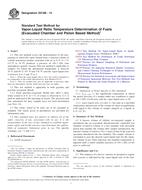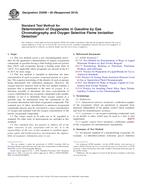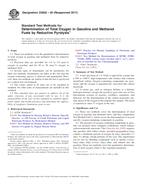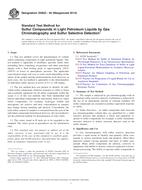We need your consent to use the individual data so that you can see information about your interests, among other things. Click "OK" to give your consent.
ASTM D5188-14
Standard Test Method for Vapor-Liquid Ratio Temperature Determination of Fuels (Evacuated Chamber and Piston Based Method)
STANDARD published on 1.1.2014
The information about the standard:
Designation standards: ASTM D5188-14
Note: WITHDRAWN
Publication date standards: 1.1.2014
SKU: NS-30187
The number of pages: 5
Approximate weight : 15 g (0.03 lbs)
Country: American technical standard
Category: Technical standards ASTM
The category - similar standards:
Annotation of standard text ASTM D5188-14 :
Keywords:
gasoline, gasoline-oxygenate blends, petroleum products, T(V/L = 20), vapor-liquid ratio, ICS Number Code 75.160.20 (Liquid fuels)
Additional information
| Significance and Use | ||||||||||
|
5.1 The tendency of a fuel to vaporize in automotive engine fuel systems is indicated by the vapor-liquid ratio of the fuel. 5.2 Automotive fuel specifications generally include T (V/L = 20) limits to ensure products of suitable volatility performance. For high ambient temperatures, a fuel with a high value of T(V/L = 20), indicating a fuel with a low tendency to vaporize, is generally specified; conversely for low ambient temperatures, a fuel with a low value of T(V/L = 20) is specified. |
||||||||||
| 1. Scope | ||||||||||
|
1.1 This test method covers the determination of the temperature at which the vapor formed from a selected volume of volatile petroleum product saturated with air at 0 °C to 1 °C (32 °F to 34 °F) produces a pressure of 101.3 kPa (one atmosphere) against vacuum. This test method is applicable to samples for which the determined temperature is between 36 °C and 80 °C (97 °F and 176 °F) and the vapor-liquid ratio is between 8 to 1 and 75 to 1. 1.2 This test method is applicable
to both gasoline and gasoline-oxygenate blends.
1.2.1 Some gasoline-oxygenate blends may show a haze when cooled to 0 °C to 1 °C. If a haze is observed in 1.3 The values stated in SI units are to be regarded as standard. The values given in parentheses are provided for information only. 1.4 This standard does not
purport to address all of the safety concerns, if any, associated
with its use. It is the responsibility of the user of this standard
to establish appropriate safety and health practices and determine
the applicability of regulatory limitations prior to use.
Standard Practice for Statistical
Assessment and Improvement of Expected Agreement Between Two Test
Methods that Purport to Measure the Same Property of a Material Standard Practice for Manual Sampling of
Petroleum and Petroleum Products Standard Test Method for Distillation of
Crude Petroleum (15-Theoretical Plate Column) Standard Practice for Applying
Statistical Quality Assurance and Control Charting Techniques to
Evaluate Analytical Measurement System Performance (Includes all
amendments and changes 12/12/2023). Standard Test Method for Vapor-Liquid
Ratio of Spark-Ignition Engine Fuels (Withdrawn 2008) |
Similar standards:
Historical
1.11.2012
Historical
1.10.2010
Historical
1.5.2011
Historical
15.1.2014
Historical
1.6.2014
Historical
1.12.2012
We recommend:
Technical standards updating
Do you want to make sure you use only the valid technical standards?
We can offer you a solution which will provide you a monthly overview concerning the updating of standards which you use.
Would you like to know more? Look at this page.



 ASTM D5598-01(2012)..
ASTM D5598-01(2012).. ASTM D5599-00(2010)..
ASTM D5599-00(2010).. ASTM D5622-95(2011)..
ASTM D5622-95(2011).. ASTM D5623-94(2014)..
ASTM D5623-94(2014).. ASTM D5705-14
ASTM D5705-14 ASTM D5708-12
ASTM D5708-12
 Cookies
Cookies
